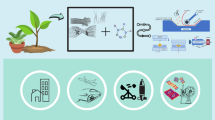Abstract
Mechanical properties of fiber-based materials, such as paper, are governed by the heterogeneous microstructure induced by the formation process. For example, in paper materials during tensile tests, lower strains are observed in the flocs (fiber aggregates where the basis weight is larger than the average one) than in the antiflocs (complement of flocs). To explain such behavior, we investigated the mechanical and structural properties of both flocs and antiflocs. Using tensile tests on flocs and antiflocs, we measured their elastic modulus and found that the elastic modulus of flocs was larger than the antiflocs’ one. To understand these differences, a multiscale structural analysis was conducted on 3D X-ray images of flocs and antiflocs at two different spatial resolutions. We found that the floc was thicker than the antifloc, whereas the microscale analysis showed the studied floc and antifloc exhibited the same bulk porosity. Then, it was concluded that the difference in elastic modulus between flocs and antiflocs is mainly due to their thickness difference.
Graphical abstract





Similar content being viewed by others
References
Krasnoshlyk V, Rolland du Roscoat S, Dumont PJJ et al (2018) Three-dimensional visualization and quantification of the fracture mechanisms in sparse fibre networks using multiscale X-ray microtomography. R Soc. https://doi.org/10.1098/rspa.2018.0175
Sampson WW (2001) The structural characterization of fibre networks in papermaking processes—a review. In:11th Fundamental research symposium 1205–1288
Farnood RR, Dodson CTJ, Loewen SR (1995) Modeling flocculation, part I, random disk model. J Pulp Pap Sci 21:348–355
Dodson CTJ, Sampson WW (1996) The effect of paper formation and grammage on its pore size distribution. J Pulp Pap Sci 22:J165–J169
Sara H (1978) The characterization and measurement of paper formation with standard deviation and power spectrum. Doctoral thesis: Helsinki University
Deng M, Dodson CTJ (1994) Random star patterns and paper formation. TAPPI 77:195–199
Alava M, Niskanen K (2006) The physics of paper. Reports Prog Phys 69:669–723. https://doi.org/10.1088/0034-4885/69/3/R03
Niskanen K (2012) Mechanics of paper products
Thorpe JL (1981) Paper as an orthotropic thin plate. TAPPI 64:119
Korteoja M, Lukkarinen A, Kaski K (1997) Computational study of formation effects on paper strength. J Pulp Pap Sci 23:18
Alexander SD, Marton R (1968) Effect of beating and wet pressing on fiber and sheet properties. II Sheet properties TAPPI 51:283–288
Luner P, Kärnä AE, Donofrio C (1961) Studies in interfiber bonding of paper. TAPPI 44:409
Mohlin UB (1992) Influence of grammage on sheet strength properties. In: progress paper physics seminar Otaniemi, Finland, 12
Rolland du Roscoat S, Decain M, Thibault X et al (2007) Estimation of microstructural properties from synchrotron X-ray microtomography and determination of the REV in paper materials. Acta Mater 55:2841–2850. https://doi.org/10.1016/j.actamat.2006.11.050
I’Anson SJ, Sampson WW (2007) Competing Weibull and stress-transfer influences on the specific tensile strength of a bonded fibrous network. Compos Sci Technol 67:1650–1658. https://doi.org/10.1016/j.compscitech.2006.07.002
I’Anson SJ, Sampson WW, Savani S (2008) Density dependent influence of grammage on tensile properties of handsheets. J Pulp Pap Sci 34:182–189
Wong L, Kortschot MT, Dodson CT (1996) Effect of formation on local strain fields and fracture of paper. J Pulp Pap Sci 22:213–219
Hagman A, Nygårds M (2017) Thermographical analysis of paper during tensile testing and comparison to digital image correlation. Exp Mech 57:325–339. https://doi.org/10.1007/s11340-016-0240-4
Krasnoshlyk V, Rolland du Roscoat S, Dumont PJJ, Isaksson P (2018) Influence of the local mass density variation on the fracture behavior of fiber network materials. Int J Solids Struct 138:236–244. https://doi.org/10.1016/j.ijsolstr.2018.01.016
Alzweighi M, Mansour R, Lahti J et al (2021) The influence of structural variations on the constitutive response and strain variations in thin fibrous materials. Acta Mater 203:116–460. https://doi.org/10.1016/j.actamat.2020.11.003
Yan H, Norman B, Lindström T, Ankerfors M (2006) Fibre length effect on fibre suspension flocculation and sheet formation. Nord Pulp Pap Res J 21:30–35. https://doi.org/10.3183/npprj-2006-21-01-p030-035
Moral A, Monte MC, Cabeza E, Blanco A (2010) Morphological characterization of pulps to control paper properties. Cellul Chem Technol 44:473–480
Svensson S, Aronsson M (2003) Using distance transform based algorithms for extracting measures of the fiber network in volume images of paper. IEEE Trans Syst Man Cybern Part B Cybern 33:562–571. https://doi.org/10.1109/TSMCB.2003.814296
Sternberg SR (1983) Biomedical image processing. IEEE Comput 16:22–34. https://doi.org/10.4018/jhisi.2012010105
Vernhes P, Bloch J, Mercier C et al (2008) Statistical analysis of paper surface microstructure: a multi-scale approach. Appl Surf Sci 254:7431–7437. https://doi.org/10.1016/j.apsusc.2008.06.023
Massey FJ (1951) The Kolmogorov-Smirnov test for goodness of fit. J Am Stat Assoc 46:68–78. https://doi.org/10.1080/01621459.1951.10500769
Acknowledgements
Laboratoire 3SR is part of the LabEx Tec 21 (Investissements d'Avenir—Grant agreement n° ANR-11-LABX-0030). We acknowledge the financial support of the PolyNat Carnot Institute (Investissements d'Avenir—Grant Agreement No. ANR-16-CARN-0025-01) through the project FLOCS. The authors gratefully acknowledge Monika Król for the paper handsheet making and Fanta Goita for her help during the tensile test experimental campaign.
Author information
Authors and Affiliations
Corresponding author
Ethics declarations
Conflict of interest
There are no conflicts to declare.
Additional information
Handling Editor: Stephen Eichhorn.
Publisher's Note
Springer Nature remains neutral with regard to jurisdictional claims in published maps and institutional affiliations.
Supplementary Information
Below is the link to the electronic supplementary material.
Rights and permissions
About this article
Cite this article
Villette, F., Rolland du Roscoat, S., Dufour, F. et al. Toward the link between structural and mechanical properties of fiber aggregates in paper materials. J Mater Sci 57, 7587–7599 (2022). https://doi.org/10.1007/s10853-022-07098-8
Received:
Accepted:
Published:
Issue Date:
DOI: https://doi.org/10.1007/s10853-022-07098-8




